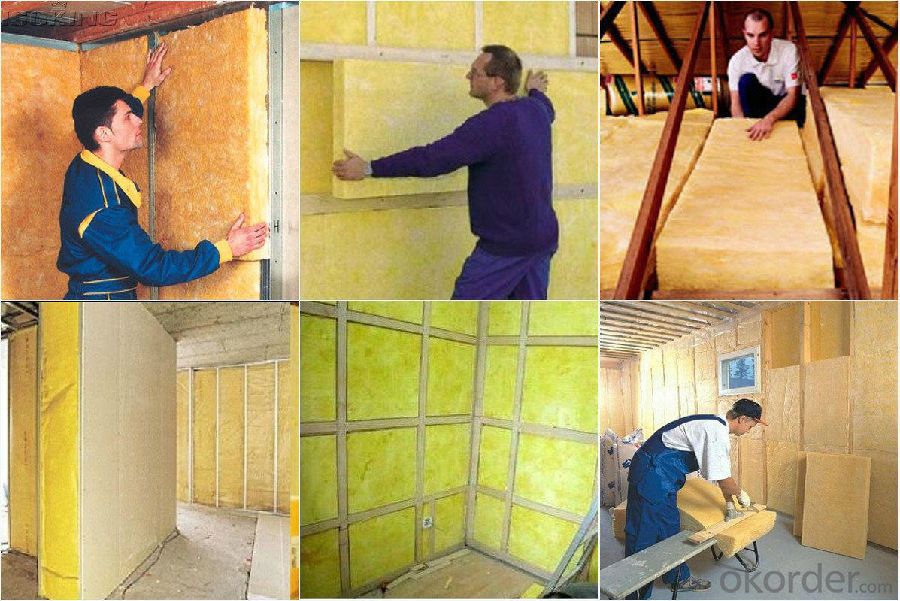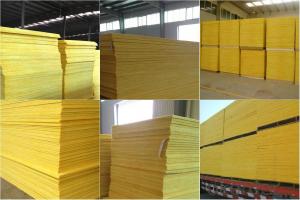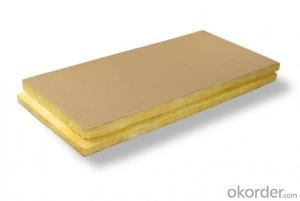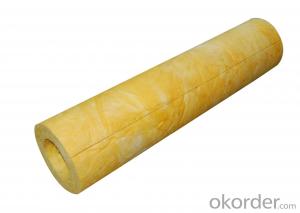glass wool&Glass wool insulation with aluminum foil faced
- Loading Port:
- Tianjin
- Payment Terms:
- TT OR LC
- Min Order Qty:
- 5000 m²
- Supply Capability:
- 20000 m²/month
OKorder Service Pledge
OKorder Financial Service
You Might Also Like
1.Description of Glass Wool Blanket:
glass wool is made by adopting unique centrifugal technology and adding environmental adhesives of thermosetting resinsbased into molten glass fibrosis. It is a kind of elastic glass fiber product made of glass fiber with diameter of only a few microns, and we can also choose moisture-proof facing on-line compound according to customers' requirements. Because of a large number of tiny air interspaces, it has the functions of heat insulation, sound absorption, safe guarding and etc, so it is the best materials of heat insulation and sound absorption in construction.
2.Main features of Glass Wool Blanket:
• Unique technology; rebound degree after compressive packing is up to 99.2%.
• Soft and long glass fibers can maximally lessen flying catkins in the construction.
• Sound absorption and noise reduction; it can effectively prevent sound from spreading.
3.Glass Wool Blanket Images:


4. Glass Wool Insulation Blanket Technical Parameters:
Property | High/low temperature resistance, oil and fuel resistance, weathering resistance, O zone resistance etc. |
Shape | According to your requirement. |
Color | Any color is available ,according to your requirements. |
Material | NBR, CR, SBR, EPDM, IIR, NR, EP, Silicone, VITON etc. |
Hardness | 30-90ShoreA |
Delivery | In 10 days |
Packing | Plastic bag & carton box or according to your requirements. |
Application | Electronic field, industrial machine & equipment, house-hold appliance, telecommunication, automobile, medical equipment industry etc. |
5.FAQ
We have organized several common questions for our clients,may help you sincerely:
①How about your company?
A world class manufacturer & supplier of Glass Wool Blanket is one of the large scale professional investment casting production bases in China,consisting of both casting foundry forging and machining factory. Annually more than 8000 tons Precision casting and forging parts are exported to markets in Europe,America and Japan. OEM casting and forging service available according to customer’s requirement.
②How to guarantee the quality of the products?
We have established the international advanced quality management system every link from raw material to final product we have strict quality test; We resolutely put an end to unqualified products flowing into the market. At the same time, we will provide necessary follow-up service assurance.
- Q:How does fiberglass mat tissue perform in terms of mold and mildew resistance?
- Fiberglass mat tissue generally performs well in terms of mold and mildew resistance. The material's non-porous nature and moisture resistance help inhibit the growth of mold and mildew. Additionally, fiberglass mat tissue is often treated with anti-fungal agents during the manufacturing process, further enhancing its resistance to mold and mildew. However, it is important to note that proper installation and maintenance are crucial to ensure optimal mold and mildew resistance.
- Q:Can fiberglass mat tissue be used for making lightweight flooring?
- Making lightweight flooring is possible with the use of fiberglass mat tissue. This material is commonly found in the construction and manufacturing industries due to its strength, durability, and lightweight properties. It is created by bonding fine fiberglass strands together with a binder, resulting in a thin, flexible, and lightweight material. Using fiberglass mat tissue for flooring applications offers various advantages. Firstly, its lightweight nature makes it easy to handle and install, reducing the overall weight of the flooring system. This is particularly beneficial in situations where weight is a concern, such as in aircraft or mobile homes. Additionally, fiberglass mat tissue has an excellent strength-to-weight ratio, making it perfect for creating lightweight yet strong flooring. It reinforces and improves the structural integrity of the flooring, making it more resistant to cracking, warping, and other types of damage. Moreover, fiberglass mat tissue is resistant to moisture, chemicals, and fire, making it suitable for areas where these factors are present, such as bathrooms, kitchens, or industrial settings. It also provides good insulation properties, which helps maintain a comfortable indoor environment and reduces energy consumption. In conclusion, fiberglass mat tissue is an excellent choice for creating lightweight flooring due to its strength, durability, moisture resistance, and insulation properties. However, it is important to consider additional factors, such as the specific requirements of the flooring application, load-bearing capacity, and necessary certifications or standards before finalizing the use of fiberglass mat tissue in a flooring project.
- Q:Is fiberglass mat tissue suitable for sound absorption?
- Yes, fiberglass mat tissue is suitable for sound absorption. Fiberglass has excellent acoustic properties, making it an effective material for reducing noise levels and improving sound quality in various applications. The fibrous structure of the mat tissue provides a high surface area to absorb sound waves, converting them into heat energy. This makes it an ideal material for soundproofing walls, ceilings, and floors in buildings, as well as for use in automotive, industrial, and marine applications. Additionally, fiberglass mat tissue is lightweight, easy to install, and has good durability and fire resistance, further enhancing its suitability for sound absorption purposes.
- Q:Can fiberglass mat tissue be used for repairing fiberglass surfboards?
- Repairing fiberglass surfboards can be accomplished using fiberglass mat tissue. This material is commonly utilized for reinforcing and fixing fiberglass structures, such as surfboards. Its lightweight nature, flexibility, and ease of use make it the perfect choice for patching up any cracks or holes in a surfboard's fiberglass shell. To bond the mat tissue to the surfboard's surface, epoxy resin is typically applied, resulting in a robust and long-lasting repair. Nonetheless, it is crucial to acknowledge that the success of the repair depends on the skill and technique of the individual performing it. If you lack experience in surfboard repairs, it is highly recommended to seek professional assistance or guidance.
- Q:Does fiberglass mat tissue have any fire-resistant properties?
- Fiberglass mat tissue indeed possesses fire-resistant properties. Its composition of glass fibers and a thermosetting resin inherently grants it fire resistance. When subjected to high temperatures or flames, fiberglass mat tissue resists ignition and combustion, instead hindering flame propagation and aiding fire containment. As a result, fiberglass mat tissue proves suitable for fire protection necessities in various applications, including insulation, fire barriers, and fireproof panels. Nevertheless, it is crucial to acknowledge that although fiberglass exhibits fire resistance, it remains susceptible to melting or burning in extreme circumstances.
- Q:Can fiberglass mat tissue be used for insulating windows?
- Yes, fiberglass mat tissue can be used for insulating windows. Fiberglass mat tissue is a lightweight and flexible material that is commonly used for insulation purposes. It has high thermal resistance and is capable of reducing heat loss or gain through windows. By placing a layer of fiberglass mat tissue on the window surface, it can help to improve the insulation properties of the window, reducing drafts and heat transfer. Additionally, fiberglass mat tissue is also effective in reducing noise transmission through windows, making it a versatile option for both thermal and acoustic insulation.
- Q:Can fiberglass mat tissue be used for insulation in refrigeration systems?
- Yes, fiberglass mat tissue can be used for insulation in refrigeration systems. Fiberglass is a common material used for insulation due to its excellent thermal properties and resistance to moisture. Fiberglass mat tissue is specifically designed to provide insulation and is often used in the construction of refrigeration systems. It helps to minimize heat transfer and maintain the desired temperature inside the system. Additionally, fiberglass is lightweight, durable, and easy to install, making it a popular choice for insulation in refrigeration systems.
- Q:Can fiberglass mat tissue be used for architectural applications?
- Certainly! Fiberglass mat tissue is applicable for architectural purposes. This versatile material offers numerous advantages when utilized in architectural undertakings. It functions predominantly as a reinforcement material for the construction of architectural components such as roofs, facades, and walls. The principal benefit of fiberglass mat tissue for architectural use lies in its exceptional strength-to-weight ratio. It provides outstanding structural integrity while remaining lightweight, rendering it highly suitable for extensive architectural ventures. Moreover, fiberglass mat tissue exhibits durability and resistance against severe weather conditions, enabling its application both indoors and outdoors. Furthermore, fiberglass mat tissue possesses commendable fire resistance attributes, a vital aspect in adhering to architectural safety standards. With a high melting point and the absence of flame propagation, it proves to be a dependable choice for fire-resistant applications. In terms of aesthetics, fiberglass mat tissue can be effortlessly molded into various shapes and designs, granting architects the freedom to explore creative possibilities. It can be painted or coated to achieve the desired visual appearance, thus establishing its versatility as an architectural finishing material. In conclusion, fiberglass mat tissue emerges as a trustworthy and adaptable material suitable for diverse architectural projects. Its strength, durability, fire resistance, and aesthetic flexibility make it an ideal choice for a wide spectrum of architectural applications.
- Q:Can fiberglass mat tissue be used in automotive manufacturing?
- Yes, fiberglass mat tissue can be used in automotive manufacturing. It is commonly used as a reinforcement material for various components such as body panels, bumpers, and interior parts. It provides strength, durability, and excellent resistance to corrosion and heat, making it an ideal choice for automotive applications.
- Q:Is fiberglass mat tissue safe to handle?
- Fiberglass mat tissue is generally considered safe for handling, but it is crucial to take specific precautions to reduce potential risks. This material consists of delicate glass fibers that, if mishandled, can become airborne and cause skin, eye, and respiratory irritation. To ensure safety, it is recommended to wear personal protective equipment like gloves, safety goggles, and a dust mask while handling fiberglass mat tissue. This will prevent direct contact with the fibers and inhalation of loose particles. Working in a well-ventilated space is also advised to lower the concentration of airborne fibers. Additionally, careful handling is essential to avoid physical injuries. The fibers can be sharp and cause cuts or abrasions if not handled properly. It is advisable to use appropriate tools and techniques when cutting, shaping, or manipulating the material. Proper disposal is equally important when dealing with fiberglass waste. Sweeping or vacuuming the area where fiberglass mat tissue was handled should be avoided, as it can disperse fibers into the air. Instead, opt for damp cleaning methods or specialized vacuum cleaners with HEPA filters to contain the fibers and minimize exposure risks. By adhering to these safety precautions and handling guidelines, the potential dangers associated with fiberglass mat tissue can be effectively minimized, ensuring safe handling and use of the material.
1. Manufacturer Overview |
|
|---|---|
| Location | |
| Year Established | |
| Annual Output Value | |
| Main Markets | |
| Company Certifications | |
2. Manufacturer Certificates |
|
|---|---|
| a) Certification Name | |
| Range | |
| Reference | |
| Validity Period | |
3. Manufacturer Capability |
|
|---|---|
| a)Trade Capacity | |
| Nearest Port | |
| Export Percentage | |
| No.of Employees in Trade Department | |
| Language Spoken: | |
| b)Factory Information | |
| Factory Size: | |
| No. of Production Lines | |
| Contract Manufacturing | |
| Product Price Range | |
Send your message to us
glass wool&Glass wool insulation with aluminum foil faced
- Loading Port:
- Tianjin
- Payment Terms:
- TT OR LC
- Min Order Qty:
- 5000 m²
- Supply Capability:
- 20000 m²/month
OKorder Service Pledge
OKorder Financial Service
Similar products
New products
Hot products
Hot Searches
Related keywords



























